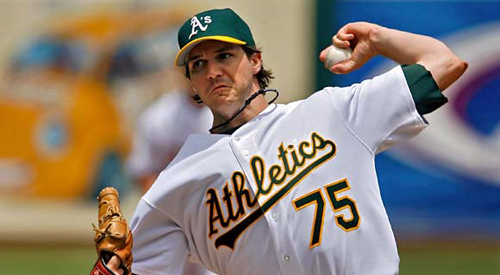
Moneyball’s transition from book to movie
Later this year, baseball fans and movie watchers alike will be united by the film adaptation of the best-selling Michael Lewis book Moneyball. Though a fascinating read in its own right, perhaps just as intriguing as the book itself has been the path the story has taken to production.
Alas, after far too many unanswered questions and changes in direction, the film is officially on the horizon. Just ask former Rajai Davis, who as a member of the Oakland Athletics in the 2010 campaign saw the project unfold first-hand for better and worse.
“It was obviously present last year because they were filming while we were there,” says Davis, surprisingly one of the few who hasn’t yet read the book. “They had their tents set up, they had their crew, their cast there.”
Scheduled to hit theaters in late September, the film focuses on the trials and tribulations of Oakland Athletics general manager Billy Beane as he struggles to build a successful franchise despite limited financial resources back in 2002.
We can all remember the A’s back at the beginning of last decade. Even with far less money to offer than their Major League counterparts, the franchise somehow flirted with 90- and even 100-win plateaus on an annual basis.
Although their track record in the postseason left a lot to be desired, Beane’s work embracing technology and effectively utilizing data earned the respect of baseball minds the world over.
In the book, Lewis details everything from the 2002 MLB Draft (in which the Athletics selected Nick Swisher and Joe Blanton) to Beane’s stathead obsession with Kevin Youkilis. Focused on the Oakland organization, it also deals thoroughly with then-A’s studs Eric Chavez and Barry Zito.
[php snippet=1]
Given the unorthodox ways in which Beane went about maximizing his team’s budget to produce a winner, it really is no surprise that the story would have its place on the silver screen eventually.
That it happened so soon – or with Brad Pitt cast to play Beane himself, for that matter – is an entirely different story.
But the path Moneyball has taken since its 2003 launch until now hasn’t been as simple as it sounds.
Around this time two years ago, the film adaptation initially started to pick up steam in the industry. Even The Good Point jumped on the movie’s bandwagon with a 2009 column on the fascinating decision to cast comedian Demetri Martin as Paul DePodesta, Beane’s trusted assistant and Sundance Kid.
At the time, filming was set to begin in June, 2009, but that’s when the wheels started to come off for then-director Steven Soderbergh, original script writer Stan Chervin, and the movie’s initial vision. Until literally days before the cameras started to roll, the Moneyball movie was set to include player interviews from real athletes involved in the story arc.
The docudrama was met with a curveball shortly thereafter, however, as the film’s higher ups scrambled to put the project on hold. It wasn’t until later in the year when Moneyball 2.0 was announced with a trimmed-down budget and a more typical feature film feel.
When filming began in the summer of 2010, the vibe of the endeavor was different. Not only had the direction of the film changed considerably, but the budget had been cut by nearly 25%. It’s alleged that even star Pitt agreed to a reworking of his contract in order to allow production to take place.
By downsizing from a $60 million budget to around $47 million it is speculated that Columbia Pictures protected themselves from potential loss in the event that the baseball-heavy story strikes out with the international media.
Another major difference, and an ultimately more visible one for movie goers, was the absence of Martin.
Along with the thinner payroll and revamped director stylings came the casting of Jonah Hill as DePodesta, replacing Martin. Hill, of Funny People and Superbad fame, will see his successful career continue to take shape as he expands the range of characters he portrays.
But regardless of which actors ultimately got the final nod to recreate the underdog tale of the early noughties, the true story behind the film now just five months away is the man from whom the original novel was inspired: Beane.
With all things considered surrounding the compelling former prospect star-turned-executive sensation, it’s almost as if Beane’s story would intrigue regardless of how it was handled in Hollywood.
“The Billy Beane behind the scenes I really don’t know,” says a soft-spoken Davis, reflecting internally on his three years with the apparent legend and his organization. “I just know that he likes to win. He does what he can do to get his team to win.”
[php snippet=1]

